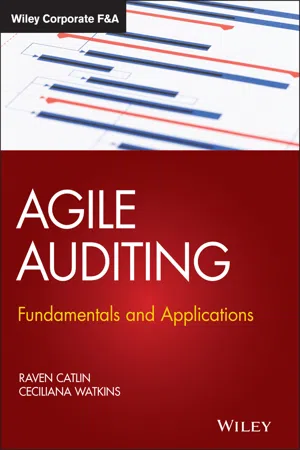
- English
- ePUB (mobile friendly)
- Available on iOS & Android
About this book
Master new, disruptive technologies in the field of auditing
Agile Auditing: Fundamentals and Applications introduces readers to the applications and techniques unlocked by tested and proven agile project management principles. This book educates readers on an approach to auditing that emphasizes risk-based auditing, collaboration, and speedy delivery of meaningful assurance assessments while ensuring quality results and a focus on the areas that pose the greatest material risks to the business under audit.
The discipline of auditing has been forever changed via the introduction of new technologies, including:
- Machine learning
- Virtual Conferencing
- Process automation
- Data analytics
Hugely popular in software development, the agile approach is just making its way into the field of audit. This book provides concrete examples and practical solutions for auditors who seek to implement agile techniques and methods.
Agile Auditing is perfect for educators, practitioners, and students in the auditing field who are looking for ways to introduce greater levels of efficiency and effectiveness to their discipline.
Frequently asked questions
- Essential is ideal for learners and professionals who enjoy exploring a wide range of subjects. Access the Essential Library with 800,000+ trusted titles and best-sellers across business, personal growth, and the humanities. Includes unlimited reading time and Standard Read Aloud voice.
- Complete: Perfect for advanced learners and researchers needing full, unrestricted access. Unlock 1.4M+ books across hundreds of subjects, including academic and specialized titles. The Complete Plan also includes advanced features like Premium Read Aloud and Research Assistant.
Please note we cannot support devices running on iOS 13 and Android 7 or earlier. Learn more about using the app.
Information
PART 1
Building an Understanding of Agile and Auditing
CHAPTER 1
What Is Agile?
AGILE IS A FRAMEWORK
DEFINITIONS OF AGILE
- More team‐level decision‐making
- Faster development time
- Faster response to shifting customer demands
- Faster problem solving
- More customer satisfaction
- Smaller teams
- Less expense
- Less wasted effort
- Fewer features in the end product that either don't work or are never used (Mathis 2013)
| Agile as a Methodology | Agile as a Mindset | Agile as a Movement |
|---|---|---|
| Practices matter more than mindset. | Mindset matters more than practices. | Mindset and practices are inexorably connected. |
| The practices and methods of Agile were already determined by others. | The principles and values of Agile were already determined by others. | I have an active role to play in determining how Agile principles and practices are articulated and applied in my team or organization. |
| Individuals within teams must collaborate and interact in prescribed and predefined ways. | Individuals within teams must independently develop an Agile mindset. | Individuals within team must work together toward a shared set of goals and values. |
- The traditional model, otherwise called waterfall, is a predictive life cycle where the project scope, time, and cost are determined in the early phases of the cycle. Any changes to scope are carefully managed. However, Agile is an adaptive life cycle and it may be iterative and incremental.
- “In an iterative life cycle, the project scope is generally determined early in the project life cycle, but time and cost estimates are routinely modified as the project team's understanding of the product increases. Iterations develop the product through a series of repeated cycles, while increments successively add to the functionality of the product.” Iterative means repetitious actions. In Agile, iterations of project designing, planning, executing, testing, inspecting, and improving are repeated until a project is complete. The iterations increase functionality during a project until it is complete. In comparison, the waterfall includes single stages for designing (requirements definition), planning (project planning), testing/execution, and inspecting. In waterfall, the project constraints of scope, time, and cost are estimated at the beginning of a project. Agile frameworks determine and allow for flexibility on scope, time, and cost during an iteration.
- “In an incremental life cycle, the deliverable is produced through a series of iterations that successively add functionality within a predetermined time frame. The deliverable contains the necessary and sufficient capability to be considered complete only after the final iteration.
- “Adaptive life cycles are Agile, iterative, or incremental. The detailed scope is defined and approved before the start of an iteration. Adaptive life cycles are also referred to as Agile or change‐driven life cycles.
- “A hybrid life cycle is a combination of a predictive and an adaptive life cycle. Those elements of the project that are well known or have fixed requirements follow predictive development life cycle, and those elemen...
Table of contents
- Cover
- Table of Contents
- Title Page
- Copyright
- Dedication
- Tables and Figures
- Foreword
- Preface
- Acknowledgments
- About the Authors
- List of Acronyms
- Introduction
- Part 1: Building an Understanding of Agile and Auditing
- Part 2: Implementing Agile Auditing
- Part 3: Special Considerations
- Glossary of Terms
- Appendix A: Appendix A:Product Backlog Template
- Appendix B: Appendix B:Agile Audit Example
- Bibliography
- Index
- End User License Agreement